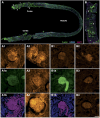Molecular Signatures of Glomerular Neovascularization in a Patient with Diabetic Kidney Disease
- PMID: 37533147
- PMCID: PMC10861111
- DOI: 10.2215/CJN.0000000000000276
Molecular Signatures of Glomerular Neovascularization in a Patient with Diabetic Kidney Disease
Abstract
The Kidney Precision Medicine Project (KPMP) aims to create a kidney tissue atlas, define disease subgroups, and identify critical cells, pathways, and targets for novel therapies through molecular investigation of human kidney biopsies obtained from participants with AKI or CKD. We present the case of a 66-year-old woman with diabetic kidney disease who underwent a protocol KPMP kidney biopsy. Her clinical history included diabetes mellitus complicated by neuropathy and eye disease, increased insulin resistance, hypertension, albuminuria, and relatively preserved glomerular filtration rate (early CKD stage 3a). The patient's histopathology was consistent with diabetic nephropathy and arterial and arteriolar sclerosis. Three-dimensional, immunofluorescence imaging of the kidney biopsy specimen revealed extensive periglomerular neovascularization that was underestimated by standard histopathologic approaches. Spatial transcriptomics was performed to obtain gene expression signatures at discrete areas of the kidney biopsy. Gene expression in the areas of glomerular neovascularization revealed increased expression of genes involved in angiogenic signaling, proliferation, and survival of endothelial cells, as well as new vessel maturation and stability. This molecular correlation provides additional insights into the development of kidney disease in patients with diabetes and spotlights how novel molecular techniques used by the KPMP can supplement and enrich the histopathologic diagnosis obtained from a kidney biopsy.
Copyright © 2023 by the American Society of Nephrology.
Conflict of interest statement
D. Barwinska reports other interests or relationships with Kidney Precision Medicine Project. J.M. Henderson reports consultancy for Novartis and Pfizer and research funding from Pfizer, Q32 Bio, and Visterra. C.L. Phillips reports ownership interest in Alphabet, Berkshire Hathaway, and Disney. P.S. Silva reports consulting and speaker fees from Bayer, Novartis, and Roche and research funding from Kubota Vision, Optomed, and Optos. D.W. Steenkamp reports consultancy for Abbott Diabete Care and grant funding to institution from Abbott Diabetes Care, Novo Nordisk, and Tandem Diabetes Care. A. Verma reports advisory or leadership roles for Editorial Boards for
Figures




References
Publication types
MeSH terms
Grants and funding
- U01DK114866/DK/NIDDK NIH HHS/United States
- U01 DK114866/DK/NIDDK NIH HHS/United States
- U01DK114908/DK/NIDDK NIH HHS/United States
- U01 DK133097/DK/NIDDK NIH HHS/United States
- U01DK133766/DK/NIDDK NIH HHS/United States
- U01DK133081/DK/NIDDK NIH HHS/United States
- U01 DK114933/DK/NIDDK NIH HHS/United States
- U01 DK114908/DK/NIDDK NIH HHS/United States
- U01 DK133095/DK/NIDDK NIH HHS/United States
- U01 DK114907/DK/NIDDK NIH HHS/United States
- U01DK133097/DK/NIDDK NIH HHS/United States
- U01DK133768/DK/NIDDK NIH HHS/United States
- U01 DK114920/DK/NIDDK NIH HHS/United States
- U01DK114933/DK/NIDDK NIH HHS/United States
- U01 DK114923/DK/NIDDK NIH HHS/United States
- U24DK114886/DK/NIDDK NIH HHS/United States
- U01 DK133113/DK/NIDDK NIH HHS/United States
- U01DK133095/DK/NIDDK NIH HHS/United States
- U01 DK133090/DK/NIDDK NIH HHS/United States
- U01DK133091/DK/NIDDK NIH HHS/United States
- U01DK114920/DK/NIDDK NIH HHS/United States
- U01 DK133768/DK/NIDDK NIH HHS/United States
- U01 DK133092/DK/NIDDK NIH HHS/United States
- U01 DK133081/DK/NIDDK NIH HHS/United States
- U01DK114907/DK/NIDDK NIH HHS/United States
- U01DK114923/DK/NIDDK NIH HHS/United States
- U01 DK133091/DK/NIDDK NIH HHS/United States
- U01 DK133093/DK/NIDDK NIH HHS/United States
- U01DK133093/DK/NIDDK NIH HHS/United States
- U24 DK114886/DK/NIDDK NIH HHS/United States
- U01DK133090/DK/NIDDK NIH HHS/United States
- U01DK133113/DK/NIDDK NIH HHS/United States
- U01 DK133766/DK/NIDDK NIH HHS/United States
LinkOut - more resources
Full Text Sources
Medical

